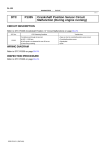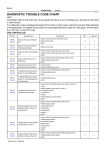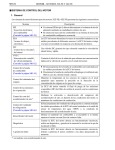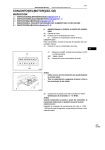Download Toyota P0325 User's Manual
Transcript
DI–71 DIAGNOSTICS – ENGINE DI38A–03 DTC P0325 Knock Sensor 1 Circuit Malfunction CIRCUIT DESCRIPTION The knock sensor is fitted to the cylinder block to detect engine knocking. This sensor contains a piezoelectric element which generates a voltage when it becomes deformed, which occurs when the cylinder block vibrates due to knocking. If engine knocking occurs, ignition timing is retarded to suppress it. DTC No. P0325 DTC Detecting Condition No knock sensor 1 signal to ECM with engine speed, 2,000 rpm or more Trouble Area S Open or short in knock sensor 1 circuit S Knock sensor 1 (looseness) S ECM HINT: If the ECM detects above diagnosis conditions, it operates the fail safe function in which the corrective retard angle value is set to the maximum value. WIRING DIAGRAM ECM 1 EB1 W A W 27 E5 KNK1 (Shielded) J1 J/C 1 A K1 Knock Sensor BR ED A09120 INSPECTION PROCEDURE HINT: Read freeze frame data using TOYOTA hand–held tester or OBD II scan tool. Because freeze frame records the engine conditions when the malfunction is detected, when troubleshooting it is useful for determining whether the vehicle was running or stopped, the engine warmed up or not, the air–fuel ratio lean or rich, etc. at the time of the malfunction. 2000 CELICA (RM744U) DI–72 DIAGNOSTICS 1 – ENGINE Check continuity between terminal KNK of ECM connector and body ground. PREPARATION: (a) Remove the ECM cover. (b) Disconnect the E5 connector of the ECM. CHECK: Measure resistance between terminal KNK of the ECM connector and body ground. OK: Resistance: 1 MΩ or higher LOCK KNK1 A09086 A09094 OK Go to step 3. NG 2 Check knock sensor 1 (See page SF–68). NG Replace knock sensor 1. OK 3 Check for open and short in harness and connector between ECM and knock sensor 1 (See page IN–30). NG OK 2000 CELICA (RM744U) Repair or replace harness or connector. DI–73 DIAGNOSTICS 4 – ENGINE Does malfunction disappear when a good knock sensor 1 is installed? YES Replace knock sensor 1. NO Check and replace ECM (See page IN–30). Reference: INSPECTION USING OSCILLOSCOPE S With the engine racing (4,000 rpm) measure between terminal KNK of the ECM connector and body ground. HINT: The correct waveforms are as shown. KNK signal waveform 0.5V/ Division 0V S 5 m sec./Division 0.5V/ Division Spread the time on the horizontal axis, and confirm that period of the wave is 80 µ sec. (Normal mode vibration frequency of knock sensor: 12.5 kHz (1ZZ–FE), 7.1 kHz (2ZZ–GE)) HINT: If normal mode vibration frequency is not 7.6 kHz the sensor is malfunctioning. 0V 100 sec./Division A00406 2000 CELICA (RM744U)











